Related Research Articles

Fable is a literary genre: a succinct fictional story, in prose or verse, that features animals, legendary creatures, plants, inanimate objects, or forces of nature that are anthropomorphized, and that illustrates or leads to a particular moral lesson, which may at the end be added explicitly as a pithy maxim or saying.

Seamus Justin Heaney was an Irish poet, playwright and translator. He received the 1995 Nobel Prize in Literature. Among his best-known works is Death of a Naturalist (1966), his first major published volume. Heaney was recognised as one of the principal contributors to poetry during his lifetime. American poet Robert Lowell described him as "the most important Irish poet since Yeats", and many others, including the academic John Sutherland, have said that he was "the greatest poet of our age". Robert Pinsky has stated that "with his wonderful gift of eye and ear Heaney has the gift of the story-teller." Upon his death in 2013, The Independent described him as "probably the best-known poet in the world".

Aesop's Fables, or the Aesopica, is a collection of fables credited to Aesop, a slave and storyteller believed to have lived in ancient Greece between 620 and 564 BCE. Of diverse origins, the stories associated with his name have descended to modern times through a number of sources and continue to be reinterpreted in different verbal registers and in popular as well as artistic media.
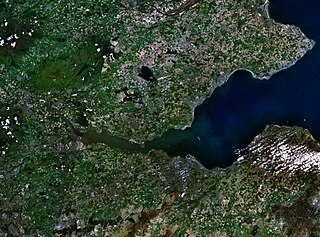
Robert Henryson was a poet who flourished in Scotland in the period c. 1460–1500. Counted among the Scots makars, he lived in the royal burgh of Dunfermline and is a distinctive voice in the Northern Renaissance at a time when the culture was on a cusp between medieval and renaissance sensibilities. Little is known of his life, but evidence suggests that he was a teacher who had training in law and the humanities, that he had a connection with Dunfermline Abbey and that he may also have been associated for a period with Glasgow University. His poetry was composed in Middle Scots at a time when this was the state language. It is one of the most important bodies of work in the canon of early Scottish literature.
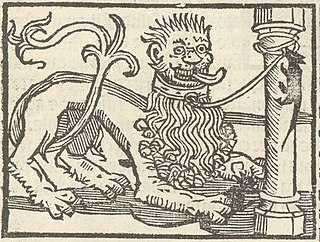
The Lion and the Mouse is one of Aesop's Fables, numbered 150 in the Perry Index. There are also Eastern variants of the story, all of which demonstrate mutual dependence regardless of size or status. In the Renaissance the fable was provided with a sequel condemning social ambition.

The Town Mouse and the Country Mouse is one of Aesop's Fables. It is number 352 in the Perry Index and type 112 in Aarne–Thompson's folk tale index. Like several other elements in Aesop's fables, 'town mouse and country mouse' has become an English idiom.

The Dog and Its Reflection is one of Aesop's Fables and is numbered 133 in the Perry Index. The Greek language original was retold in Latin and in this way was spread across Europe, teaching the lesson to be contented with what one has and not to relinquish substance for shadow. There also exist Indian variants of the story. The morals at the end of the fable have provided both English and French with proverbs and the story has been applied to a variety of social situations.
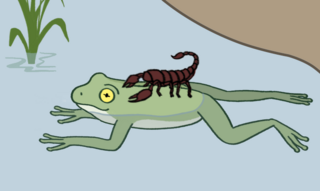
The Scorpion and the Frog is an animal fable which teaches that vicious people often cannot resist hurting others even when it is not in their interests. This fable seems to have emerged in Russia in the early 20th century, although it was likely inspired by more ancient fables.
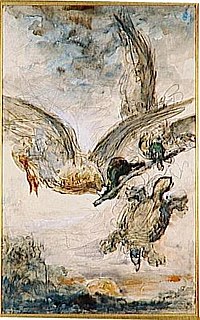
The Tortoise and the Birds is a fable of probable folk origin, early versions of which are found in both India and Greece. There are also African variants. The moral lessons to be learned from these differ and depend on the context in which they are told.

Gualterus Anglicus was an Anglo-Norman poet and scribe who produced a seminal version of Aesop's Fables around the year 1175.

The Morall Fabillis of Esope the Phrygian is a work of Northern Renaissance literature composed in Middle Scots by the fifteenth century Scottish makar, Robert Henryson. It is a cycle of thirteen connected narrative poems based on fables from the European tradition. The drama of the cycle exploits a set of complex moral dilemmas through the figure of animals representing a full range of human psychology. As the work progresses, the stories and situations become increasingly dark.
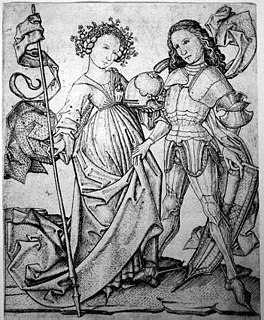
The Testament of Cresseid is a narrative poem of 616 lines in Middle Scots, written by the 15th-century Scottish makar Robert Henryson. It is his best known poem. It imagines a tragic fate for Cressida in the medieval story of Troilus and Criseyde which was left untold in Geoffrey Chaucer's version. Henryson's cogent psychological drama, in which he consciously resists and confronts the routine depiction of Cressida (Cresseid) as simply 'false', is one of the features that has given the poem enduring interest for modern readers and it is one of the most admired works of northern renaissance literature. A modern English translation by Seamus Heaney, which also included seven of Henryson's fables from The Morall Fabillis, was published in 2009.

"The Taill of the Uponlandis Mous and the Burges Mous", also known as "The Twa Mice," is a Middle Scots adaptation of Aesop's Fable The Town Mouse and the Country Mouse by the Scottish poet Robert Henryson. Written around the 1480s, it is the second poem in Henryson's collection called The Morall Fabillis of Esope the Phrygian.

"The Taill of the Cok and the Jasp" is a Middle Scots version of Aesop's Fable The Cock and the Jewel by the 15th-century Scottish poet Robert Henryson. It is the first in Henryson's collection known as the Morall Fabillis of Esope the Phrygian. The Cok and the Jasp is framed by a prologue and a moralitas, and as the first poem in the collection it operates on a number of levels, and in all its parts, to introduce the larger cycle.

"The Taill of Schir Chanticleir and the Foxe" is Fabill 3 of Robert Henryson's cycle of thirteen Morall Fabillis composed in Scotland in the later fifteenth century. It is the first of the fable in the poem to be based on Reynardian and beast epic sources rather than on any strictly Aesopian original, although the closest match from Aesop might be The Dog, the Cock and the Fox.
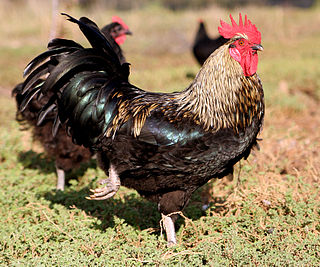
The Cock and the Jewel is a fable attributed to Aesop. It is one of a number that feature only a single animal. As a trope in literature, the fable is reminiscent of stories used in zen such as the kōan. It presents, in effect, a riddle on relative values and is capable of many interpretations, depending on the point of view from which it is regarded.

The Wolf and the Lamb is a well-known fable of Aesop and is numbered 155 in the Perry Index. There are several variant stories of tyrannical injustice in which a victim is falsely accused and killed despite a reasonable defence.

The Fox, the Wolf and the Husbandman is a poem by the 15th-century Scottish poet Robert Henryson and part of his collection of moral fables known as the Morall Fabillis of Esope the Phrygian. It is written in Middle Scots. As with the other tales in the collection, appended to it is a moralitas which elaborates on the moral that the fable is supposed to contain. However, the appropriateness of the moralitas for the tale itself has been questioned.

The Frog and the Mouse is one of Aesop's Fables and exists in several versions. It is numbered 384 in the Perry Index. There are also Eastern versions of uncertain origin which are classified as Aarne-Thompson type 278, concerning unnatural relationships. The stories make the point that the treacherous are destroyed by their own actions.

The Dog and the Sheep is one of Aesop’s Fables and is numbered 478 in the Perry Index. Originally its subject was the consequence of bearing false witness. However, longer treatments of the story during the Middle Ages change the focus to deal with perversions of justice by the powerful at the expense of the poor. It has sometimes been alternatively titled The Wolf, the Dog and the Sheep in order to distinguish it from the fable of the dispute between the sheep and the dog that guards them.
References
Modern edition
- Henryson, Robert (2009). The Testament of Cresseid & seven fables . Trans. by Seamus Heaney. London: Faber and Faber. ISBN 9780571249282.